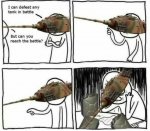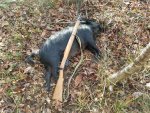Hitler used his experience in WWI as the armature around which he would personally ordain the means and the methods for winning. He got a number of those means and methods dead wrong as a consequence. Mainly, he was a politician who micromanaged the process when his own generally accepted as highly capable General Staff could have been more than equal to the task. Like all defeats, it was, at its heart, a political one. Hitler's cronies were crucial to his taking domestic power, and equally crucial to his wasting it away from home.
Britain was crucial to either side's potential victory. In dropping the objective of destroying the RAF prematurely during the Battle of Britain, the Luftwaffe allowed the wolf to gnaw away at its innards, and ultimately crashed on that rocky little atoll.
Britain became the ultimate unsinkable aircraft carrier, which wasted tens of thousands of Allied and Axis lives trying to turn massive bombardment into a terror weapon. It failed at that utterly, and didn't do much better at destroying industrial might until it was fully clear that the crossing of the Channel had already decided the outcome. Whichever side did that was going to achieve final victory.
Following the Invasion, Britain served as the materials marshaling yard that keep the invasion rolling.
Thee is no question that most of the rifles employed were bolt guns. Those who fully employed the semi's and full autos (Garand, PPSH-41, etc.) won the war. Halfhearted weapons employment gave halfhearted results. Like those here who wish to to be adept and effective, it's really as much the Indian as the bow or the arrow that really counts. The bolt rifles, even the M-N 91/30, were all excellent enough, in numbers, to be effective firearms. But choosing the best among them is choosing from the also-rans. Post-War, bolt guns were winding down in a crash dive; the semi- and fully-auto-capable rifle dominated from then on.
Germany used gas chambers because bullets were too expensive; when their generals warned that the Sturm Gewehr/Assault Rifle was too wasteful of ammunition, for them, it was a damning criticism. The Allies used overwhelming firepower in the fire and maneuver basic squad tactic that finally made the Stuka actually obsolete, and demonstrated conclusively that the bolt rifle was no longer a viable main battle rifle. No objective came without an accompanying gush of blood; it was the balance of firepower which decided which side bled more. In Germany, the intricacy of its weapons meant there would be fewer of them. In the USA, it was the industrial clout that made the Garand possible as an across the force implement, instead of the rare and exquisite mademoiselle that the SVT-40 and the StG-44 were doomed to become. Keep it simple, or keep it numerous. Tanks to rifles, it was the industries that kept them coming in numbers that made inferior models, like the M-4 Sherman and the T-34, to overwhelm and invalidate the Germans' exquisite technical superiority.
Patton was right about the Garand, but without the industry to build it in vast numbers, and keep it fed, it was just another interesting historical curiosity. Stalin put it simply enough, "Quantity has a quality all it's own...").
The Second World War was simply the First World War continued to its proper ending, with the Germans demonstrating again and finally that they are great at starting wars, and equally great at losing them. When the mounds of rifles piled up at the surrenders across Germany, they were bolt guns. IMHO, on the question about which of the bolt action main battle rifles was the best, my answer is, none of them.
Greg
Britain was crucial to either side's potential victory. In dropping the objective of destroying the RAF prematurely during the Battle of Britain, the Luftwaffe allowed the wolf to gnaw away at its innards, and ultimately crashed on that rocky little atoll.
Britain became the ultimate unsinkable aircraft carrier, which wasted tens of thousands of Allied and Axis lives trying to turn massive bombardment into a terror weapon. It failed at that utterly, and didn't do much better at destroying industrial might until it was fully clear that the crossing of the Channel had already decided the outcome. Whichever side did that was going to achieve final victory.
Following the Invasion, Britain served as the materials marshaling yard that keep the invasion rolling.
Thee is no question that most of the rifles employed were bolt guns. Those who fully employed the semi's and full autos (Garand, PPSH-41, etc.) won the war. Halfhearted weapons employment gave halfhearted results. Like those here who wish to to be adept and effective, it's really as much the Indian as the bow or the arrow that really counts. The bolt rifles, even the M-N 91/30, were all excellent enough, in numbers, to be effective firearms. But choosing the best among them is choosing from the also-rans. Post-War, bolt guns were winding down in a crash dive; the semi- and fully-auto-capable rifle dominated from then on.
Germany used gas chambers because bullets were too expensive; when their generals warned that the Sturm Gewehr/Assault Rifle was too wasteful of ammunition, for them, it was a damning criticism. The Allies used overwhelming firepower in the fire and maneuver basic squad tactic that finally made the Stuka actually obsolete, and demonstrated conclusively that the bolt rifle was no longer a viable main battle rifle. No objective came without an accompanying gush of blood; it was the balance of firepower which decided which side bled more. In Germany, the intricacy of its weapons meant there would be fewer of them. In the USA, it was the industrial clout that made the Garand possible as an across the force implement, instead of the rare and exquisite mademoiselle that the SVT-40 and the StG-44 were doomed to become. Keep it simple, or keep it numerous. Tanks to rifles, it was the industries that kept them coming in numbers that made inferior models, like the M-4 Sherman and the T-34, to overwhelm and invalidate the Germans' exquisite technical superiority.
Patton was right about the Garand, but without the industry to build it in vast numbers, and keep it fed, it was just another interesting historical curiosity. Stalin put it simply enough, "Quantity has a quality all it's own...").
The Second World War was simply the First World War continued to its proper ending, with the Germans demonstrating again and finally that they are great at starting wars, and equally great at losing them. When the mounds of rifles piled up at the surrenders across Germany, they were bolt guns. IMHO, on the question about which of the bolt action main battle rifles was the best, my answer is, none of them.
Greg
Last edited:







